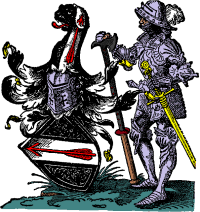

 by Woodward and Burnett, and with all due acknowledgment I take from that work the subjoined extract:--
by Woodward and Burnett, and with all due acknowledgment I take from that work the subjoined extract:--*1 Plate XI. Fig. 10, Laing's "Catalogue," No. 29. At each side of the King's seated figure on the counter-seal of Robert II. (1386) the arms of Scotland are supported from behind by a skeleton within an embattled buttress ("Catalogue," No. 34).Of instances of single objects from which shields are found depending or supported the "Treatise on Heraldry"

 states:--
states:-- |
| FIG. 666.--Arms of Sigmund Hagelshaimer. |

 will be found in Fig. 666. In this the figure partakes more of the character of a shield guardian than a shield supporter. The arms are those of "Sigmund Hagelshaimer," otherwise "Helt," living at Nürnberg. The arms are "Sable, on a bend argent, an arrow gules." The crest is the head and neck of a hound sable, continued into a mantling sable, lined argent. The crest is charged with a pale argent, and thereupon an arrow as in the arms, the arrow-head piercing the ear of the hound.
will be found in Fig. 666. In this the figure partakes more of the character of a shield guardian than a shield supporter. The arms are those of "Sigmund Hagelshaimer," otherwise "Helt," living at Nürnberg. The arms are "Sable, on a bend argent, an arrow gules." The crest is the head and neck of a hound sable, continued into a mantling sable, lined argent. The crest is charged with a pale argent, and thereupon an arrow as in the arms, the arrow-head piercing the ear of the hound. Theybear: "Argent, on a fesse sable, three 'P's' argent." The wings which form the crest are charged with the same device. This curious charge of the three letters is explained in the following saying:--
Theybear: "Argent, on a fesse sable, three 'P's' argent." The wings which form the crest are charged with the same device. This curious charge of the three letters is explained in the following saying:-- "Piper Peperit Pecuniam,
Pecunia Peperit Pompam,
Pompa Peperit Pauperiem,
Pauperies Peperit Pietatem."
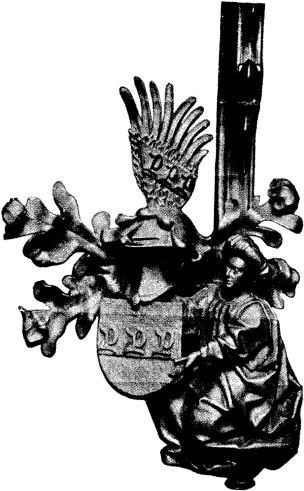 |
| FIG. 667.--Arms of Vöhlin of Argsberg. |

 who writes: "Take the case of the well-known coat of the Hays, and hear the description of its origin as given by Nisbet: 'In the reign of Kenneth III., about the year 980, when the Danes invaded Scotland, and prevailing in the battle of Luncarty, a country
Scotsman with his two sons, of great strength and courage, having rural weapons, as the yokes of their plough, and such plough furniture, stopped the Scots in their flight in a certain defile, and upbraiding them with cowardice, obliged them to rally, who with them renewed the battle, and gave a total overthrow to the victorious Danes; and it is said by some, after the victory was obtained, the old man lying on the ground, wounded and fatigued, cried, "Hay, Hay," which word became a surname to his posterity. He and his sons being nobilitate, the King gave him the aforesaid arms (argent, three escutcheons gules) to intimate that the father and the two sons had been luckily the three shields of Scotland, and gave them as much land in the Carse of Gowrie as a falcon did fly over without lighting, which having flown a great way, she lighted on a stone there called the Falcon Stone to this day. The circumstances of which story is not only perpetuated by the three escutcheons, but by the exterior ornaments of the achievement of the family of Errol; having for crest, on a wreath, a falcon proper; for supporters two men in country habits, holding the oxen-yokes of a plough over their shoulders; and for motto, "Serva jugum."'
who writes: "Take the case of the well-known coat of the Hays, and hear the description of its origin as given by Nisbet: 'In the reign of Kenneth III., about the year 980, when the Danes invaded Scotland, and prevailing in the battle of Luncarty, a country
Scotsman with his two sons, of great strength and courage, having rural weapons, as the yokes of their plough, and such plough furniture, stopped the Scots in their flight in a certain defile, and upbraiding them with cowardice, obliged them to rally, who with them renewed the battle, and gave a total overthrow to the victorious Danes; and it is said by some, after the victory was obtained, the old man lying on the ground, wounded and fatigued, cried, "Hay, Hay," which word became a surname to his posterity. He and his sons being nobilitate, the King gave him the aforesaid arms (argent, three escutcheons gules) to intimate that the father and the two sons had been luckily the three shields of Scotland, and gave them as much land in the Carse of Gowrie as a falcon did fly over without lighting, which having flown a great way, she lighted on a stone there called the Falcon Stone to this day. The circumstances of which story is not only perpetuated by the three escutcheons, but by the exterior ornaments of the achievement of the family of Errol; having for crest, on a wreath, a falcon proper; for supporters two men in country habits, holding the oxen-yokes of a plough over their shoulders; and for motto, "Serva jugum."'
 who gives (p. 144) a cut from the achievement of the French D'ALBRETS as "the most singular supporters, perhaps, in the whole circle of heraldry." These supporters are two lions couchant (or), each helmed, and crested with an eagle au vol leve. These eagles certainly assist in holding the shield, but the lions are its true supporters; nor is this arrangement by any means unique. The swans which were used as supporters by JEAN, Due DE BERRI, in 1386, are each mounted upon a bear. Two wild men, each à cheval on a lion, support the escutcheons of GERARD D'HARCHIES (1476) and of NICOLE DE GIRESME (1464). Two lions sejant, helmed and crested(the crest is a human head with the ears of an ass) were the supporters of ARNAUD D'ALBREY in 1368.
who gives (p. 144) a cut from the achievement of the French D'ALBRETS as "the most singular supporters, perhaps, in the whole circle of heraldry." These supporters are two lions couchant (or), each helmed, and crested with an eagle au vol leve. These eagles certainly assist in holding the shield, but the lions are its true supporters; nor is this arrangement by any means unique. The swans which were used as supporters by JEAN, Due DE BERRI, in 1386, are each mounted upon a bear. Two wild men, each à cheval on a lion, support the escutcheons of GERARD D'HARCHIES (1476) and of NICOLE DE GIRESME (1464). Two lions sejant, helmed and crested(the crest is a human head with the ears of an ass) were the supporters of ARNAUD D'ALBREY in 1368.*1 Armorial bearings of William Speke, Esq.: Argent, two bars azure, over all an eagle displayed with two heads gules, and as an honourable augmentation (granted by Royal Licence, dated July 26, 1867, to commemorate the discoveries of the said John Hanning Speke), a chief azure, thereon a representation of flowing water proper, superinscribed with the word "Nile" in letters gold. Upon the escutcheon is placed a helmet befitting his degree, with a mantling azure and argent; and for his crests: 1. (of honourable augmentation) upon a wreath of the colours, a crocodile proper; 2. upon a wreath of the colours, a porcupine proper; and as a further augmentation for supporters(granted by Royal Licence as above to the said William Speke, Esq., for and during his life)--on the dexter side, a crocodile; and on the sinister side, a hippopotamus, both proper; with the motto, "Super æthera virtus."Another fruitful origin of the use of unauthorised supporters at the present day lies in the fact that grants of supporters personal to the grantee for his life only have been made to Knights Grand Cross or to life peers in cases where a hereditary title has been subsequently conferred. The limitations of the grant of supporters having never been extended, the grant has naturally expired with the death of the life honour to which the supporters were attached.

 sums up the matter of inheritance in these words (see p. 357): "As already indicated, however, by one of the learned Lords in his opinion on the case of Cuninghame, the practice in the matter in question has been far from uniform: and accordingly we are very much disposed to go along with his relative suggestion, that 'the chief armorial dignities should follow the more substantial rights and dignities of the family'; and that when the latter are enjoyed by the female heir of line, such heir should also be regarded as fairly entitled to claim the principal heraldic honours."
sums up the matter of inheritance in these words (see p. 357): "As already indicated, however, by one of the learned Lords in his opinion on the case of Cuninghame, the practice in the matter in question has been far from uniform: and accordingly we are very much disposed to go along with his relative suggestion, that 'the chief armorial dignities should follow the more substantial rights and dignities of the family'; and that when the latter are enjoyed by the female heir of line, such heir should also be regarded as fairly entitled to claim the principal heraldic honours."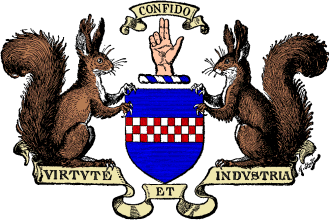 |
| FIG. 668.--The Arms used by Kilmarnock, Ayrshire: Azure, a fess chequy gules and argent. Crest: a dexter hand raised in benediction. Supporters: on either side a squirrel sejant proper. |
 the supporters are "Dexter: 'St. Thomas à Becket,' and sinister, a Baron of Scotland." Another instance, again from Scotland, appears in a most extraordinary grant by the Lyon in 1816 to Sir Jonathan Wathen Waller, Bart., of Braywick Lodge, co. Berks, and of Twickenham, co. Middlesex. In this case the supporters were two elaborately "harnessed" ancient warriors, "to commemorate the surrender of Charles, Duke of Orleans, at the memorable battle of Agincourt (that word being the motto over the crest) in the year 1415, to Richard Waller of Groombridge in Kent, Esq., from which Richard the said Sir
Jonathan Wathen Waller is, according to the tradition of his family, descended." This pedigree is set out in Burke's Peerage, which assigns as arms to this family the old coat of Waller of Groombridge, with the augmented crest, viz.: "On a mount vert, a walnut-tree proper, and pendent there from an escutcheon of the arms of France with a label of three points argent." Considerable doubt, however, is thrown upon the descent by the fact that in 1814, when Sir Jonathan (then Mr. Phipps) obtained a Royal Licence to assume the name and arms of Waller, a very different and much bedevilled edition of the arms and not the real coat of Waller of Groombridge was exemplified to him. These supporters (the grant was quite ultra vires, Sir Jonathan being a domiciled Englishman) do not appear in any of the Peerage books, and it is
not clear to what extent they were ever made use of, but in a painting which came under my notice the Duke of Orleans, in his surcoat of France, could be observed handing his sword across the front of the escutcheon to Mr. (or Sir) Richard Waller. The supporters of the Needlemakers' Company are commonly known as Adam and Eve, and the motto of the Company ["They sewed fig-leaves together and made themselves aprons"] bears this supposition out. The blazon, however, is: "Dexter, a man; sinister, a woman, both proper, each wreathed round the waist with leaves of the last, in the woman's dexter hand a needle or." The supporters of the Earl of Aberdeen are, "dexter an Earl and sinister a Doctor of Laws, both in their robes all proper."
the supporters are "Dexter: 'St. Thomas à Becket,' and sinister, a Baron of Scotland." Another instance, again from Scotland, appears in a most extraordinary grant by the Lyon in 1816 to Sir Jonathan Wathen Waller, Bart., of Braywick Lodge, co. Berks, and of Twickenham, co. Middlesex. In this case the supporters were two elaborately "harnessed" ancient warriors, "to commemorate the surrender of Charles, Duke of Orleans, at the memorable battle of Agincourt (that word being the motto over the crest) in the year 1415, to Richard Waller of Groombridge in Kent, Esq., from which Richard the said Sir
Jonathan Wathen Waller is, according to the tradition of his family, descended." This pedigree is set out in Burke's Peerage, which assigns as arms to this family the old coat of Waller of Groombridge, with the augmented crest, viz.: "On a mount vert, a walnut-tree proper, and pendent there from an escutcheon of the arms of France with a label of three points argent." Considerable doubt, however, is thrown upon the descent by the fact that in 1814, when Sir Jonathan (then Mr. Phipps) obtained a Royal Licence to assume the name and arms of Waller, a very different and much bedevilled edition of the arms and not the real coat of Waller of Groombridge was exemplified to him. These supporters (the grant was quite ultra vires, Sir Jonathan being a domiciled Englishman) do not appear in any of the Peerage books, and it is
not clear to what extent they were ever made use of, but in a painting which came under my notice the Duke of Orleans, in his surcoat of France, could be observed handing his sword across the front of the escutcheon to Mr. (or Sir) Richard Waller. The supporters of the Needlemakers' Company are commonly known as Adam and Eve, and the motto of the Company ["They sewed fig-leaves together and made themselves aprons"] bears this supposition out. The blazon, however, is: "Dexter, a man; sinister, a woman, both proper, each wreathed round the waist with leaves of the last, in the woman's dexter hand a needle or." The supporters of the Earl of Aberdeen are, "dexter an Earl and sinister a Doctor of Laws, both in their robes all proper."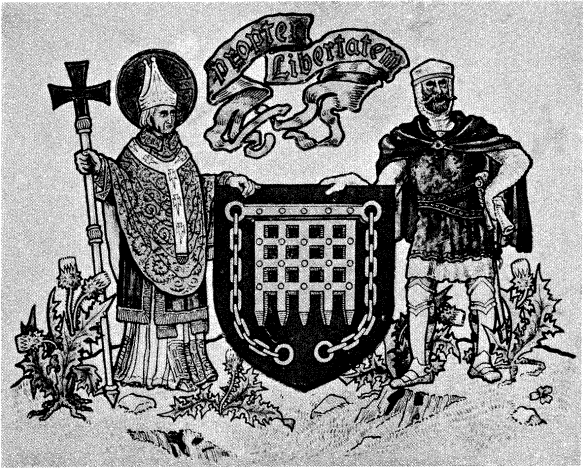 |
| FIG. 669.--Arms of Arbroath: Gules a portcullis with chains pendent or. Motto: "Proper Libertatem." Supporters: dexter, St.Thomas à Becket in his archiepiscopal robes all proper; sinister a Baron of Scotland armed cap-à-pie, holding in his exterior hand the letter from the Convention of the Scottish Estates, held at Arbroath in the year of 1320, addressed to Pope John XXII., all proper. |
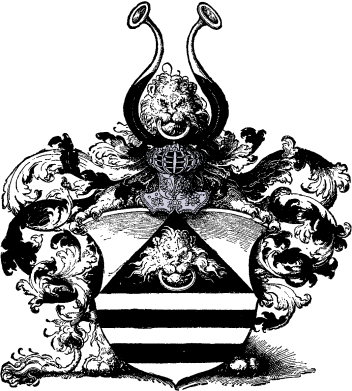 |
| FIG. 670.--Arms of Dr. Heinrich Rubische. |
*1 Arms of Glasgow: Argent, on a mount in base vert an oak-tree proper, the stem at the base thereof surmounted by a salmon on its back also proper, with a signet-ring in its mouth or, on the top of the tree a redbreast, and in the sinister fess point an ancient hand-bell, both also proper. Above this shield is placed a suitable helmet, with a mantling gules, doubled argent; and issuing from a wreath of the proper liveries is set for crest, the half-length figure of St. Kentigern affronté, vested and mitred, his right hand raised in the act of benediction, and having in his left hand a crosier, all proper. On a compartment below the shield are placed for supporters, two salmon proper, each holding in its mouth a signet-ring or, and in an escroll entwined with the compartment this motto, "Let Glasgow flourish."
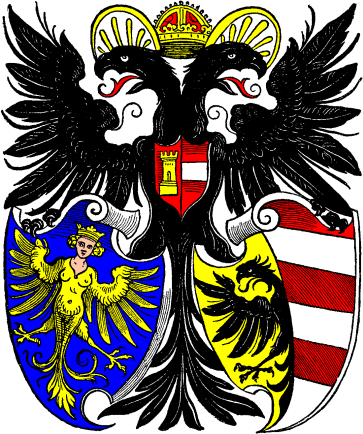 |
| FIG. 671.--The Arms of Nürnberg. |